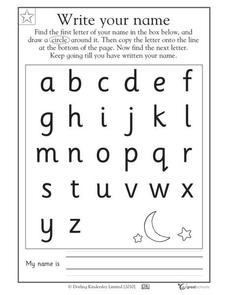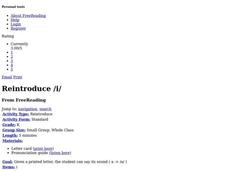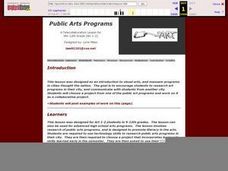Curated OER
Vowel Sounds -- Short Ee Words
In this letter and number recognition activity, learners use a secret code box to help them spell 20 short Ee words.
Curated OER
Probability Exercise
Follow fruit fly genetics with this probability activity. Biology scholars analyze the alleles of Bugsy, Daisy, Dino, and Lulu, considering traits for antennae, wing type, and eye color. They solve Punnett squares to determine the...
Curated OER
Colors
A tricky activity on color words is sure to challenge your kindergarten readers. They match color words to pictures that correspond to each color - yellow for banana, for example. Next, kids color a paint set to match four color words....
Curated OER
Genetics Practice 1: Basic Mendelian Genetics
Six genetics problems are to be solved by junior geneticists. Empty Punnett squares are provided for them to plant the parents' alleles and determine the genotype, phenotype, and frequency of offspring. All of the problems involve actual...
Curated OER
Writing an Explanation
Bananas are an important part of a healthy diet - but where do they come from? Third graders write an explanatory text about the origins of bananas. The bottom part of the paper includes necessary information about bananas, as well as a...
Curated OER
Making Words
In this word building worksheet, children color in the consonants and cut out all of the given letters. They can then construct words by arranging the letters and writing them down on columns for two through seven-letter words. This...
Curated OER
Write Your Name
Kids love to write their own name. Here is a twist on the old trace and write your name three times task. Little ones hunt through the provided alphabet and circle the letters in their name. Then they write the letters on the line...
Curated OER
Reintroduce /i/
As your scholars begin learning letters of the alphabet, help them connect sound, pronunciation, word examples, and letter recognition using these strategies. Focusing on the letter i, begin by drawing it on the board. Can scholars...
Curated OER
Electricity Lesson II: Electrical Symbols
Zap! It's time to discuss the various symbols seen when working with electrical equipment. Intended for a vocational audience, the presentation gives basic definitions, diagrams, and labels for 10 commonly seen electrical symbols.
Curated OER
Public Arts Programs
Students choose a project from one of the public art programs and work on it as a collaborative project. The goal is to encourage students to research art programs in their city, and communicate with students from another city.
Curated OER
Time That Period
Physical science starters play with a pendulum in order to experience periodicity. Detailed procedures and a worksheet are included for day one. For day two, learners will use a graphing calculator to help them plot orbit data from a...
Curated OER
AP: Chapter 23: The Evolution of Populations
How and why do populations change over time? AP biology aces explore this question by completing this assignment. They write the answers to 21 questions regarding population genetics, stability, genetic drift, polymorphism, and...
Curated OER
Amazing metals: Nevada quarter reverse
Nevada's nickname is "The Silver State" and metal is what this lesson is all about. Pupils will make a T-chart to discuss the differences between metals and minerals, then write and explain the properties of metal. They will get into...
Curated OER
Decode the Words #6 Grade 7
In this word decoding worksheet, 7th graders try to break the code to spell each word. Students are given nineteen sets of number codes where they must determine the word for each code.
Curated OER
Word Search With Vocabulary Words
In this word search worksheet, students recognize words in a puzzle. Students complete the word search by finding the fifteen words in the puzzle.
Curated OER
Critters & Complementary Colors
Students discover how specific colors compliment each other. Students use paints and pictures of animals to create a picture with analogous color harmony. They explain the characteristics of analogous colors.
Curated OER
Making Words
In this making words worksheet, students color the consonants yellow, cut out the letters, and put words together with 2 to 7 letters each. Students complete 6 columns of words.
Curated OER
Getting to Know Saturn: The Saturn System
Students compare and contrast Earth and Saturn's planet features. In this space science lesson, students draw a diagram of the solar system and identify the different components. They complete a Saturn system scavenger hunt and Venn...
Curated OER
Coal To Electricity
After observing the table that tells about the wattage, kilowatts, and estimated pounds of coal consumed annually; middle schoolers construct a bar graph that indicates the amount of coal required to run each of the following appliances...
Curated OER
Dream! (Part One)
Young scholars share with the class what they want to be when they grow up. As a class, they identify what they want to be for Halloween as well. They are videotaped stating their dream and photographed with their mask. Using the masks,...
Curated OER
Learning to Read With Jet Speed
not a lesson Student's success in school depends on the accuracy at which they can read their materials in the expected amount of time. If students do not read accurately, quickly, and effortlessly they may fall behind their...
Curated OER
Matching Words and Pictures Beginning with S
For this matching words and pictures beginning with S worksheet, 2nd graders enter the number to match the picture with the word for 6 words beginning with S, then check answers online.
Curated OER
Elements of A Story
Eighth graders read stories and identify the six elements of a story. As a group activity, they illustrate random examples of Frankinstein stories, identify the element illustrated, and post the picture in the appropriate station in the...
Curated OER
DNA Model
Students are able to construct a candy model of DNA. They are able to list all of the parts of DNA that they investigated earlier. Students are able to describe what each part of DNA does. They create an edible model of DNA strands.

























